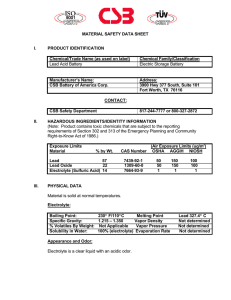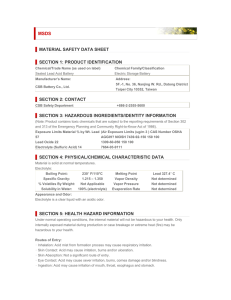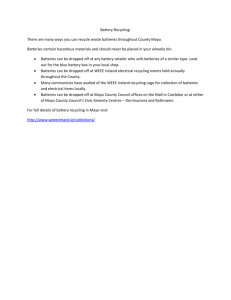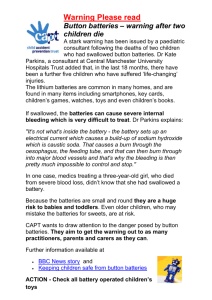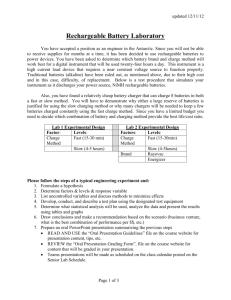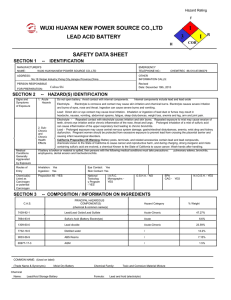LR1130 Alkaline Battery MSDS | Safety Data Sheet
advertisement
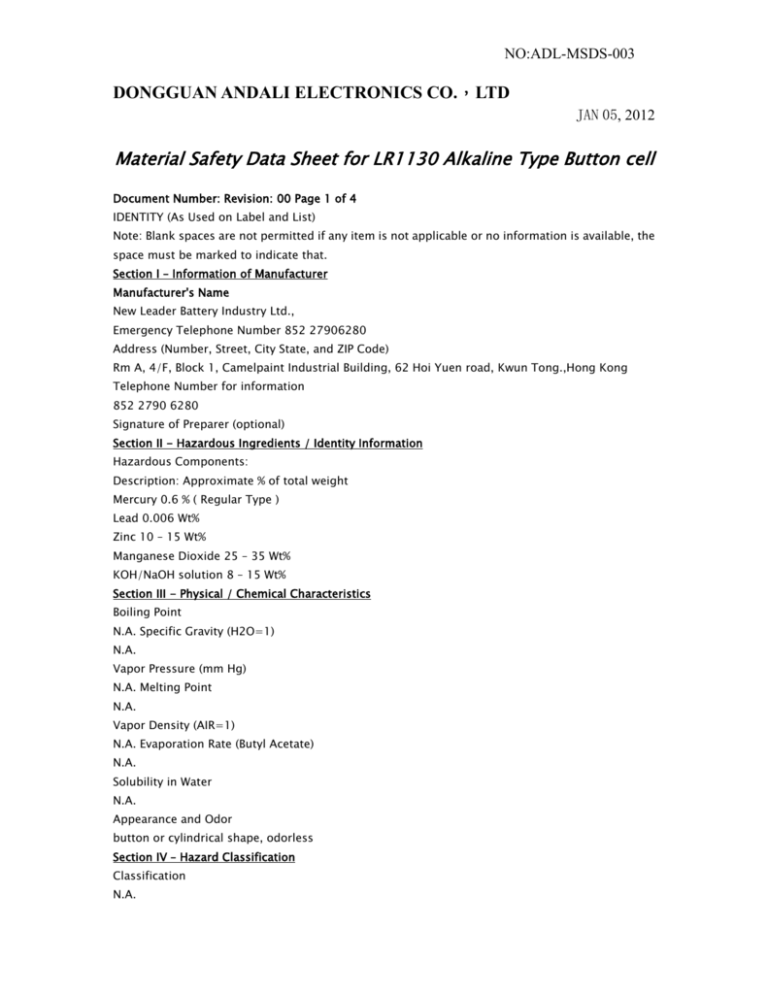
NO:ADL-MSDS-003 DONGGUAN ANDALI ELECTRONICS CO.,LTD JAN 05, 2012 Material Safety Data Sheet for LR1130 Alkaline Type Button cell Document Number: Revision: 00 Page 1 of 4 IDENTITY (As Used on Label and List) Note: Blank spaces are not permitted if any item is not applicable or no information is available, the space must be marked to indicate that. Section I – Information of Manufacturer Manufacturer's Name New Leader Battery Industry Ltd., Emergency Telephone Number 852 27906280 Address (Number, Street, City State, and ZIP Code) Rm A, 4/F, Block 1, Camelpaint Industrial Building, 62 Hoi Yuen road, Kwun Tong.,Hong Kong Telephone Number for information 852 2790 6280 Signature of Preparer (optional) Section II - Hazardous Ingredients / Identity Information Hazardous Components: Description: Approximate % of total weight Mercury 0.6 % ( Regular Type ) Lead 0.006 Wt% Zinc 10 – 15 Wt% Manganese Dioxide 25 – 35 Wt% KOH/NaOH solution 8 – 15 Wt% Section III - Physical / Chemical Characteristics Boiling Point N.A. Specific Gravity (H2O=1) N.A. Vapor Pressure (mm Hg) N.A. Melting Point N.A. Vapor Density (AIR=1) N.A. Evaporation Rate (Butyl Acetate) N.A. Solubility in Water N.A. Appearance and Odor button or cylindrical shape, odorless Section IV – Hazard Classification Classification N.A. NO:ADL-MSDS-003 Material Safety Data Sheet for LR1130 Alkaline Button cell Document Number: Revision: 00 Page 2 of 4 Section V – Reactivity Data Stability Unstable Conditions to Avoid Stable Incompatibility (Materials to Avoid) Hazardous Decomposition or Byproducts When heated, battery may emit hazardous vapour of KOH/NaOH and Hg Hazardous (Regular type) Polymerization May Occur Conditions to Avoid Will Not Occur Section VI - Health Hazard Data Route(s) of Entry Inhalation N.A. Skin N.A. Ingestion N.A. Health Hazard (Acute and Chronic) / Toxicological information In case of electrolyte leakage, skin will be itchy when contaminated with electrolyte. In contact with electrolyte can cause severe irritation and chemical burns. Inhalation of electrolyte vapors may cause irritation of the upper respiratory tract and lungs. Section VII – First Aid Measures First Aid Procedures If electrolyte leakage occurs and makes contact with skin, wash with plenty of water immediately. If electrolyte comes into contact with eyes, wash with copious amounts of water for fifteen (15) minutes, and contact a physician. If electrolyte vapors are inhaled, provide fresh air and seek medical attention if respiratory irritation develops. Ventilate the contaminated area. Section VIII - Fire and Explosion Hazard Data Flash Point (Method Used) N.A. Ignition Temp. N.A. Flammable Limits N.A. LEL N.A. UEL N.A. Extinguishing Media Carbon Dioxide, Dry Chemical or Foam extinguishers Special Fire Fighting Procedures N.A. Unusual Fire and Explosion Hazards Do not dispose of battery in fire - may explode. Do not short-circuit battery - may cause burns. NO:ADL-MSDS-003 Material Safety Data Sheet for LR1130 alkaline cell Document Number: Revision: 00 Page 3 of 4 Section IX – Accidental Release or Spillage Steps to Be Taken in Case Material is Released or Spilled Batteries that are leaking should be handled with rubber gloves. Avoid direct contact with electrolyte. Wear protective clothing and a positive pressure Self-Contained Breathing Apparatus (SCBA). Section X – Handling and Storage Safe handling and storage advice The battery is extremely sensitive to adverse effects of humidity. Be sure to store them in a place which is dry and subject to little temperature change. Do not place near the boiler or radiator, nor expose to direct sun light. Do not dispose of the battery in fire. Do not charge the battery. Do not short-circuit the battery. Do not put in backward position. Do not store in disorderly fashion, or allow metal objects to be mixed with stored batteries. Do not disassemble the battery, handling in such manner can cause the battery to explose, leak and injury. Section XI – Exposure Controls / Person Protection Occupational Exposure Limits: LTEP N.A. STEP N.A. Respiratory Protection (Specify Type) N.A. Ventilation Local Exhausts N.A. Special N.A. Mechanical (General) N.A. Other N.A. Protective Gloves N.A. Eye Protection N.A. Other Protective Clothing or Equipment N.A. Work / Hygienic Practices N.A. Section XII – Ecological Information N.A. Section XIII – Disposal Method Dispose of batteries according to government regulations. NO:ADL-MSDS-003 Material Safety Data Sheet for LR1130 alkaline cell Document Number: Revision: 00 Page 4 of 4 Section XIV – Transportation Information NL batteries are considered to be “Dry cell” batteries and are unregulated for purposes of transportation by the U.S. Department of Transportation(DOT), International Civil Aviation Administration (ICAO), International Air Transport Association (IATA) and International Maritime Dangerous Goods Regulations (IMDG). The only DOT requirement for shipping these batteries is special provision 130 which states: “Batteries, dry are not subject to the requirements of this subchapter only when they are offered for transportation in a manner that prevents the dangerous evolution of heat (For example, by the effective insulation of exposed terminals). As of 50th Edition(2009)IATA requires that batteries being transported by air must be protected from short-circuiting and protected from movement that could lead to short-circuiting. Section XV – Regulatory Information Special requirement be according to the local regulatory. Section XVI – Other Information The data in this Material Safety Data Sheet relates only to the specific material designated herein. Section XVII – Measures for fire extinction In case of fire, it is permissible to use any class of extinguishing medium on these batteries or their packing material. Cool exterior of batteries if exposed to fire to prevent rupture. Fire fighters should wear self-contained breathing apparatus.



